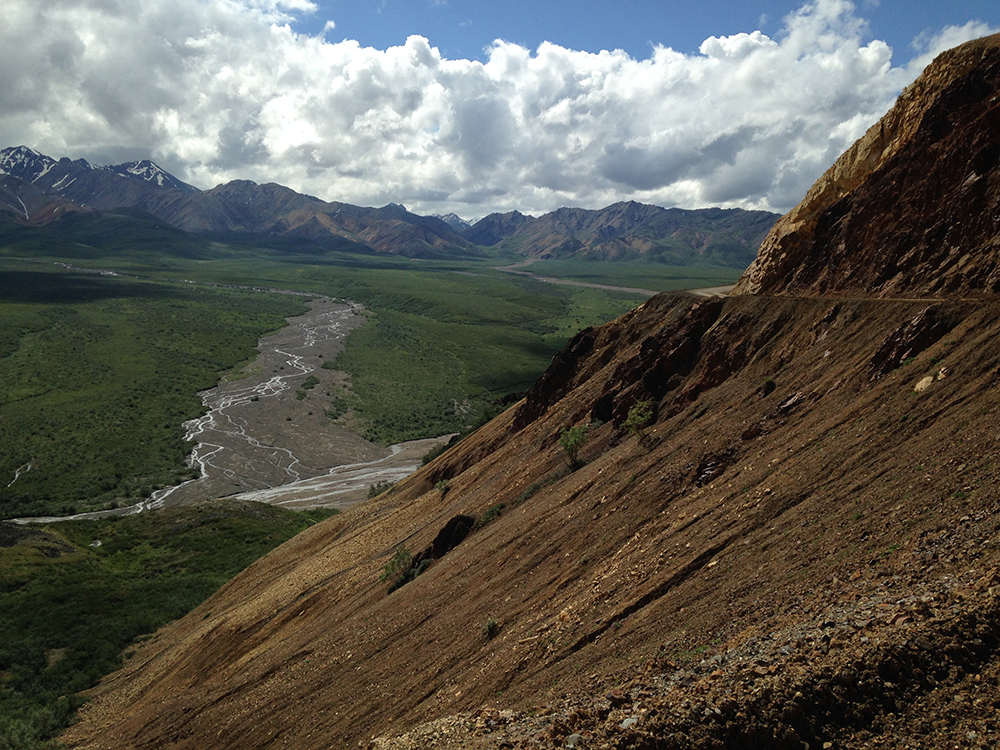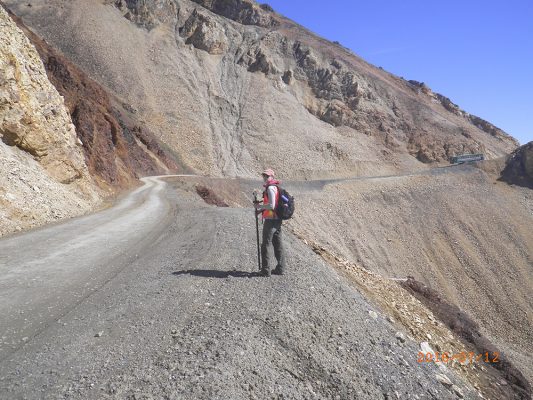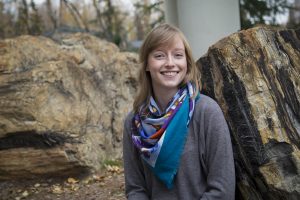UAA geology student: 'I jumped at the opportunity'
by Tracy Kalytiak |

This is the view from Anna Stanczyk's research "classroom" at Denali National Park's Polychrome Pass. (Photo provided by Anna Stanczyk)
Anna Stanczyk is a UAA geology student who, last summer, worked in Denali National Park on her undergraduate thesis project: investigating a debris slide there informally known as Pretty Rocks. Alaska Geological Society and Geophysical Society of Alaska awarded her scholarships that helped make the research possible. She also received an undergraduate research grant directly from UAA. Anna talked with us about her work:
How did you first become interested in researching this aspect of geology?

Anna Stanczyk, a UAA geology student, spent the summer at Denali National Park conducting landslide research. (Photo provided by Anna Stanczyk)
I first became interested in landslides and mass wasting in my geomorphology class last fall. I spoke with my professor, Dr. Kris Crossen, about establishing a research project and she passed this notion down the grapevine. Originally I'd envisioned a project nearby, perhaps related to rock fall along Turnagain Arm. But lo and behold, I returned from the holiday break to hear an offer was on the table to work in Denali National Park. How could I possibly turn that down? I scheduled a phone call with the park geologist, who described several projects that might be of interest.
Why did you choose to study Pretty Rocks?
Pretty Rocks attracted me both because of its potential impact on the park road-it is currently the number-one ranked geohazard in the park-as well as the location in Polychrome Pass. I jumped at the opportunity.
Where is Pretty Rocks, and why is it significant?
Pretty Rocks is taking place in a talus slope within Polychrome Pass and threatens to take out the road in an area with few options for rerouting-for those unfamiliar with Polychrome Pass, this stretch of road cuts into a steep mountainside. Significantly, Polychrome Pass precedes the Toklat rest stop, which is the final destination for a majority of park visitors.

Anna Stanczyk is a UAA geology student who previously earned a University of Colorado Boulder degree in French literature. (Photo by Theodore Kincaid / University of Alaska Anchorage)
How did this slide originally occur?
[That] is exactly what I am investigating. For more than a decade, the slide has been experiencing slow, downhill movement known as creep-style failure, and the road maintenance crew consistently adds fill to maintain the road grade. Occasional secondary failures of smaller scale have affected the road in the past. While I do not have any definitive conclusions at this point (I am still in the interpretation phase), I believe it is occurring due to a preponderance of slippery clays, as well as the degradation of permafrost.
What were the specific tasks you needed to complete in the field during the period you were there?
During our field work, my field assistant and I conducted detailed mapping of geomorphologic (surface) features using a mapping-grade GPS device; described the surrounding bedrock in detail, including structural characterizations; collected clay and soil samples, which are currently undergoing engineering tests; investigated several nearby failure areas for stratigraphic and causation comparisons and made daily visual assessments of key features, including the cracks that exist in the road at both the eastern and western extents of the slide.
How quickly is the Pretty Rocks slide occurring?
The creep-style failure is too slow for visual observation, although the gradual movement can add up quickly, as revealed by the cracks in the road. If the road maintenance crew smoothed over the cracks with material, the cracks would again be visible within 1-2 days.
How long did you stay in Denali National Park?
Overall, we spent just over three weeks in Denali and got to live in employee housing at Toklat (mile 52 within the park).
What was the experience like?
We rode shuttle buses to and from the project area, and quickly became jaded by all the wildlife sightings. We had no close encounters during our fieldwork, although a blonde brown bear visited the area several times. The upper half of the slide was also encompassed by a critical wildlife habitat closure for the majority of our time there, because a pair of golden eagles had established a nest on the bedrock adjacent to the slide. We would often see them soaring overhead, or in other areas of Polychrome Pass. The closure was finally opened just days before our departure, allowing us to step foot more than about 10 feet above the road, which had been our previous restriction. We did witness a large mudslide at a different location one evening following heavy rain. It closed the road for a few hours and we got front-row seats to the geology in action!
Where do you think this research will lead you?
The realm of geohazards fascinates me both from a geologic standpoint and from the potential impact on infrastructure and even human lives. This research project has already led to the potential to work on other failures in the park for a master's thesis. Whether I choose to return to Denali or not, the experience has connected me with numerous geologists both here in Alaska and in the Lower 48. In addition to graduate school research opportunities, of course I eventually hope it will lead to job prospects.
Compiled by Tracy Kalytiak, University of Alaska Anchorage
 "UAA geology student: 'I jumped at the opportunity'" is licensed under a Creative Commons Attribution-NonCommercial 4.0 International License.
"UAA geology student: 'I jumped at the opportunity'" is licensed under a Creative Commons Attribution-NonCommercial 4.0 International License.














